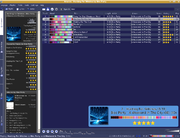
Moodbar
Encyclopedia

Music visualization
Music visualization, a feature found in electronic music visualizers and media player software, generates animated imagery based on a piece of music...
used for navigating within a piece of music. This is done with a horizontal bar that is divided into vertical stripes. Each stripe has a colour showing the "mood" within a short part of the song. The colour can depend on spectrum and/or rhythmic features of the part of the song. The parts of the song (intro, choruses, solos, accents etc.) as well as musical changes (dynamics, rhythm
Rhythm
Rhythm may be generally defined as a "movement marked by the regulated succession of strong and weak elements, or of opposite or different conditions." This general meaning of regular recurrence or pattern in time may be applied to a wide variety of cyclical natural phenomena having a periodicity or...
, texture, playing instruments) are clearly visible on the bar.
Moodbar was originally presented by Gavin Wood and Simon O’Keefe in their paper On Techniques for Content-Based Visual Annotation to Aid Intra-Track Music Navigation. Moodbar has been implemented for Amarok musicplayer, Exaile
Exaile
Exaile is a music player that was originally conceived to be similar in style and function to KDE's Amarok 1.4, but use the GTK+ widget toolkit rather than Qt...
musicplayer, and the gjay playlist creator.
As of 2008, the default implementation of Amarok's moodbar only uses the spectral content of the current section of the track. It calculates the energy in the low, medium, and high frequency bands, and turns this into the amount of red, green, and blue in the corresponding stripe. Each moodbar file is 1000 samples long, which corresponds to roughly 4-5 samples every second, for a typical 3-4 minute long song. This is not useful for telling anything about the rhythm of a song, but it is sometimes possible to guess where different instruments are playing. This can be useful for spotting verse, chorus, verse structure, and breaks in the music.
Because all moodbars are normalised to the same length, any information that might be contained within the visual texture of the bar can be very misleading, as short tracks will be displayed with greater detail.

